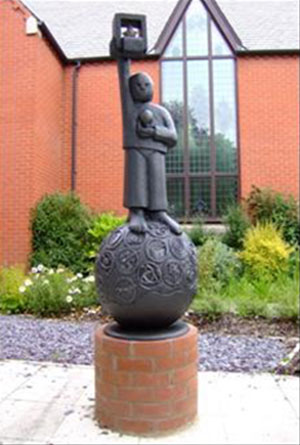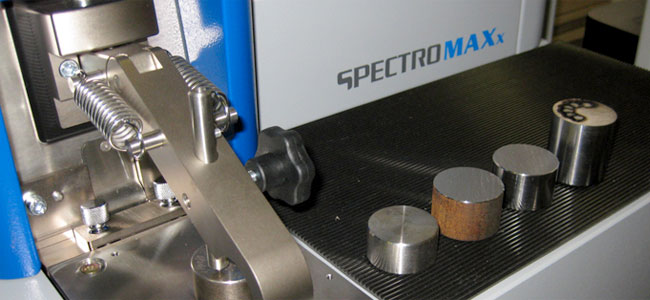News
July 2008
Sculpture Corner

By Ailsa Magnus
Ailsa Magnus decoration for new development in Hull. 1.8m. Tall Cast in SG Ductile Iron from a hollow polystyrene carving by the artist.

The Colour of Light
H. Downs & Sons invest in the Spectrometer
The most familiar colour we see when some metals are heated is the bluey/green of copper when it is put under the torch, the blues and greens dance and mingle in the flame. Look at cast iron as a liquid and you see white yellows, yellows, oranges to reds as it cools down to grey. The colours are radiated light from the different elements present in the metal. Iron, Silicon, Carbon, are the main, followed by Copper and Manganese to toughen, Magnesium to change it to an SG Ductile iron. Chrome to form carbides and harden, Nickel to strengthen and make it more resistant to heat and chemicals. Molybdenum and Tin swing the properties to and fro. Aluminium is a gas former within the iron and requires removing. Lead is a detrimental one to have around too. Phosphorus makes the iron brittle and hard, lowering tensile strength rapidly. The knowledge or which elements are present and in what quantities are important to developing the correct grade of iron required. Each of these metals burn with a distinct colour, a specific wavelength of light, and with the use of a spectrograph we can take a sample from the ladle, cool it, polish it, place it on the machine and Zap it with a high voltage charge, 12,000 volts at low amperage. This electric shock vaporisers all the elements within the sample in a 'flash of light', then, using optical refraction and diffraction methods, the light is sorted into the various different wavelengths. A charged couple device, as found in a digital cameras, records each different colour of the spectrum of light and its strength, analysing, in percentages, any element present. Our samples are restricted to 26 different elements although measuring the 27th element, our main ingredient, Iron is calculated as what is remaining of the 100 percent. Benefits to our customers and ourselves is to be able to tweak specifications before pouring from the furnace to the most accurate and economical formula. If and when customers require a chemical material certification we can send it with the advice note. However, 3.1B certification and mechanical properties will still be carried out, over a period of several days, by Keighley Laboratories our independent UKAS certified laboratory.www.spectro.com
Health and Safety
and other legislation
As the price of iron soars we have more attempts of theft. We have now got to the stage where we have to fence off the whole production site and operate an electronic gate system to keep people out so they don't steal from us, nor bless their little cotton socks, hurt themselves whilst they vermin around the site looking for an easy meal. Oh ... Jeremy Clarkson for President.
Pattern Making
2008 busiest year ever.
Pattern making has been busy all year for our six pattern makers. Producing patterns for machine tool, pumps, turbines, rollers, wheels, impellors, art and heritage as well as the renovation of existing patterns.
Incoming Patterns
and what would be really helpful...
New patterns arriving at our door are not always identifiable to the customer. A transport company arrives at our premises with several pallets of pattern and coreboxes with no name, no numbers, no delivery note from the customer. Days after we eventually identify whom the equipment might belong to. We have close to 600 customers trading on a one off basis and new patterns arriving regularly. Things we would like to see on the pattern equipment are Customer's name, raised metal letters depicting the part number and material required. Information is also entered on, the number of pattern pieces and how many coreboxes.